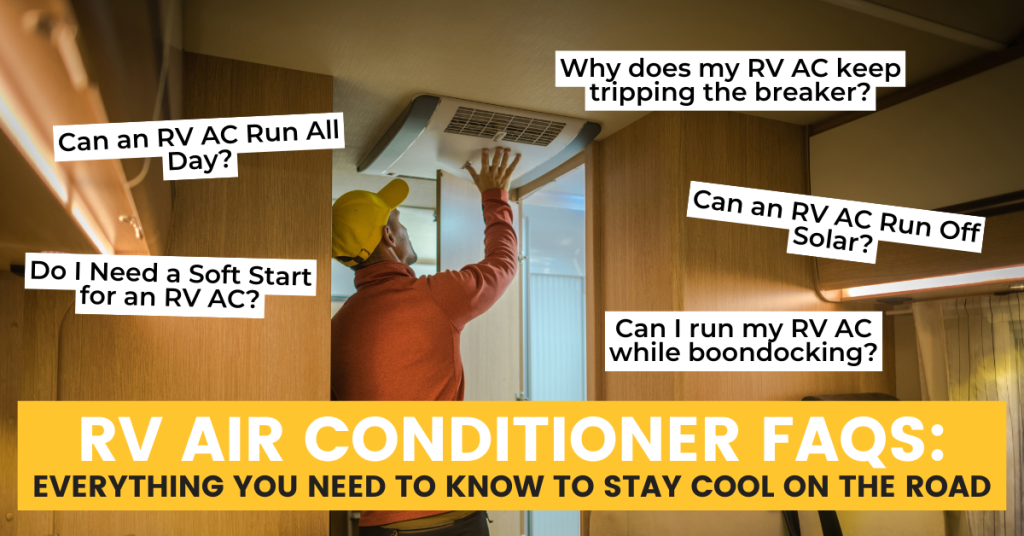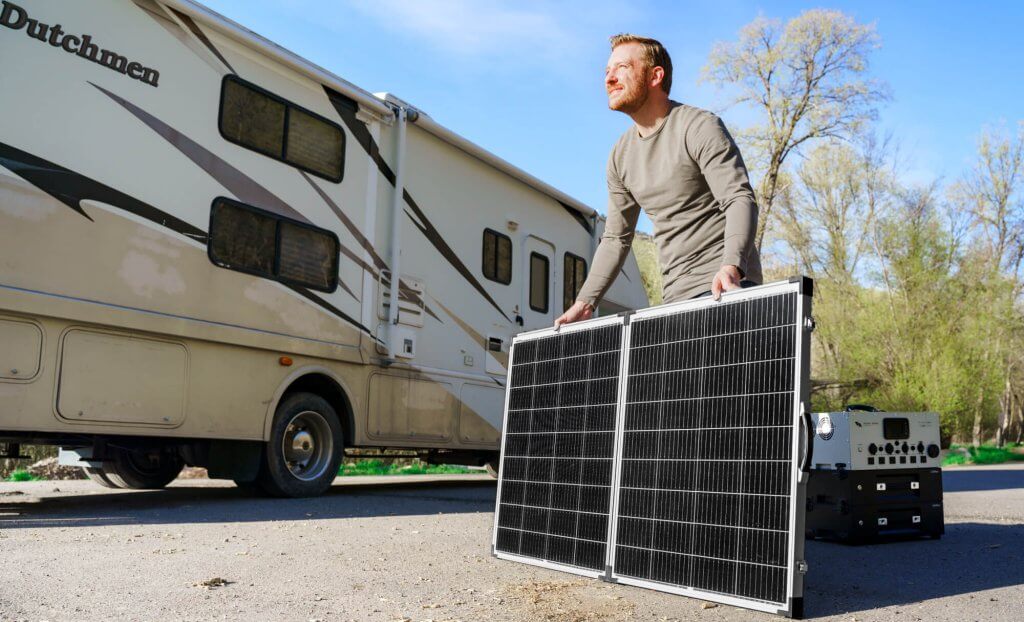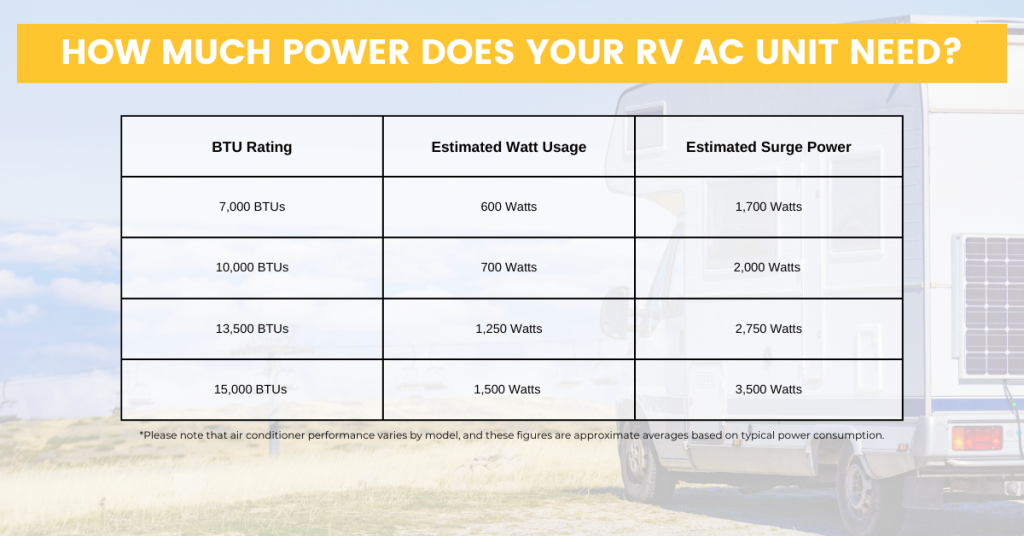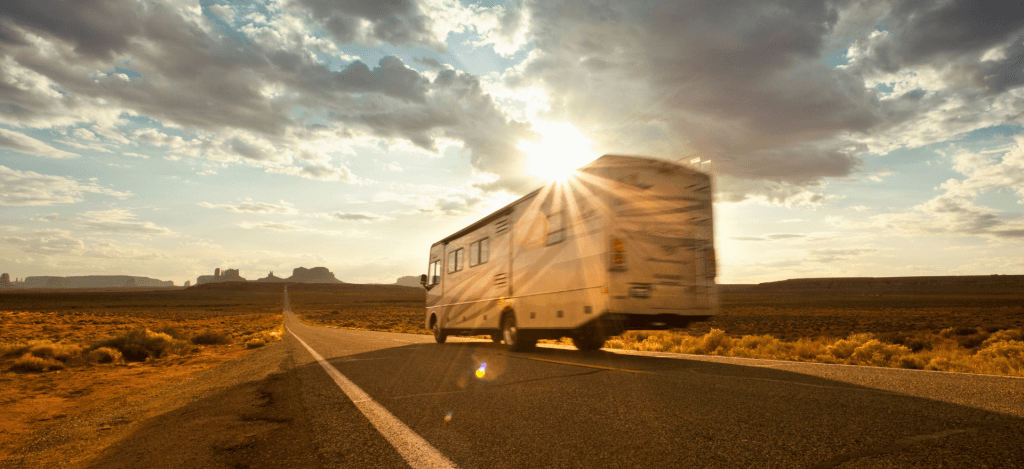Running an RV air conditioner on a power station is one of the hottest topics of conversation among RVers, and it often comes with a lot of skepticism. Many people assume that a solar-powered system simply isn’t strong enough to handle the demands of an AC unit—but that’s not the case. To clear up the confusion, we’ve put together a comprehensive FAQ that breaks down everything you need to know about running your RV AC off a power station, so you can stay cool and powered up no matter where your adventures take you.

RV air conditioning works much like the air conditioning in a home or office, but it’s designed to be compact and efficient for use in a mobile environment. It relies on the principles of refrigeration, which involve cooling the air by removing heat from the inside of the RV and transferring it outside.
Here’s a quick breakdown of the process:
The AC unit cycles on and off throughout the day to maintain the desired temperature, using compressors, coils, and refrigerants to continuously cool the air while removing heat from the RV.
It’s important to remember that RV AC units require significant power to run, especially during the startup phase when they need a surge of power to get the compressor running. Properly sizing your power source ensures that your AC unit operates efficiently and reliably while keeping your RV cool.
Yes! An RV air conditioner can absolutely run off a power station—as long as the power station is designed to handle the load. The key factors are having a high-capacity inverter that can handle the startup surge of the AC unit, a large enough battery to run it for your desired timeframe, and an efficient way to recharge, such as solar panels.
For example, the Titan 240SP Power Station features a 4,000-watt continuous inverter with an 8,000-watt surge capacity, making it powerful enough to handle even large 15,000 BTU AC units. When paired with up to 4,400 watts of solar, it can recharge throughout the day, ensuring you have reliable power for extended off-grid trips.
With the right setup, a power station can be a game-changer for RVers, providing quiet, clean energy without relying on shore power or noisy gas generators. For more information, check out this article: Is Your RV AC Too Powerful for a Solar Generator? – Point Zero Energy
Yes, an RV air conditioner can run off solar power—but it requires the right setup. Solar panels alone don’t directly power an AC unit; instead, they charge a battery system, which then supplies power to your RV AC through an inverter.
The key to running an RV AC off solar is having enough solar panels to recharge your batteries throughout the day. A standard RV air conditioner typically uses 1,200 to 1,800 watts while running, with a higher surge power on startup. To sustain this, you need a high-capacity battery bank and a strong inverter that can handle the AC’s demands.
To get the most out of your solar panels and keep your RV AC running efficiently, proper placement and maintenance are essential. Ensure your panels are in direct sunlight and free from shade, as even small obstructions can significantly reduce power output. Regularly clean your panels to remove dust, dirt, and debris that can block sunlight. If your panels are adjustable, tilting them toward the sun throughout the day can improve efficiency. Investing in high-efficiency monocrystalline solar panels can also enhance performance, especially in low-light conditions. By optimizing your solar setup, you can maximize energy absorption and keep your RV powered, even in off-grid conditions.

Yes, an RV air conditioner can run all day, but it’s important to understand how an air conditioner operates and how to maximize efficiency. Unlike a fan or a light that stays on continuously, an RV air conditioner cycles on and off throughout the day to maintain the desired temperature. This means it isn’t running at full power the entire time—it turns on when cooling is needed and shuts off once the set temperature is reached. The actual runtime depends on factors like outside temperature, insulation, and thermostat settings.
To increase the efficiency of your RV AC and reduce power consumption, follow these tips:
✔ Keep doors and windows closed – Preventing warm air from coming in will reduce how often the AC needs to cycle.
✔ Lower blinds or use reflective covers – Blocking direct sunlight helps keep your RV cooler, reducing the strain on your AC.
✔ Park in the shade – If possible, park under trees or use an awning to minimize heat buildup inside your RV. Note: This will affect your solar panel input!
✔ Keep AC filters clean – Dirty filters restrict airflow and make your AC work harder than necessary. Regularly check and clean or replace them.
✔ Use fans to circulate air – Ceiling fans or small portable fans can help distribute cool air more evenly throughout your RV.
✔ Set a reasonable temperature – The lower you set your thermostat, the harder your AC will work. Setting it at a comfortable but efficient level (like 75–78°F) can extend battery life and reduce power draw.
A soft start is a device that helps reduce the initial surge of power when starting your RV air conditioner. Normally, when you turn on your RV AC, it requires a large surge of power—often two to three times its running wattage—to start the compressor. This surge can overwhelm power systems that aren’t designed to handle it. A soft start gradually ramps up the power, preventing that immediate spike and allowing the system to run more efficiently.
Some RV AC units come with a built-in soft start feature, while others require an external soft start device. If your RV AC doesn’t have one, installing an external device can help improve performance and protect your power system from overloads.
While some systems, like our Point Zero Energy systems, are built to handle surge power, adding a soft start can still improve overall efficiency, reduce wear on your system, and ensure a smoother, more reliable operation.

The size of the generator you need for your RV air conditioner depends on the BTU rating of your AC unit and its power consumption. For most RVs, a 2,000 to 3,000-watt generator is typically sufficient to run a 13,500 BTU AC. However, if you have a larger 15,000 BTU AC or multiple air conditioners, you’ll need a 4,000 to 5,000-watt generator to handle both the running power and surge power when the unit starts up.
It’s important to choose a generator that can handle both the continuous running wattage and the startup surge, which can be two to three times the normal operating watts. Additionally, if you plan to use other appliances alongside your AC, be sure to account for their combined power needs to avoid overloading the generator.
If your RV AC keeps tripping the breaker, it usually points to a few potential issues related to power demand and system overload. One common cause is the startup surge of your air conditioner. As mentioned earlier, when the AC kicks on, it draws a large spike of power, which can trip a breaker if the power source or circuit isn’t equipped to handle it.
Another possible cause is overloading the circuit by running too many high-power appliances at the same time, like a microwave or coffee maker, which competes with your AC for power. To prevent this, try limiting your power use or spreading out the operation of appliances.
Additionally, check for faulty wiring, a loose connection, or a defective breaker. If your RV AC is older or has internal electrical issues, it could cause the breaker to trip unexpectedly. Regular maintenance, ensuring your breaker is rated for the load, and adding a soft start device can all help reduce the chances of this happening.
Yes, many RV air conditioners can run on 110V power, but it depends on the power requirements of your specific unit. Most smaller RV air conditioners, such as those with a 13,500 BTU rating and below, can typically operate on a standard 110V outlet. However, when running on 110V, you may need to be mindful of the amp draw to ensure that the circuit can handle it, especially considering the startup surge that can temporarily increase the power demand.
Larger air conditioners, like those with a 15,000 BTU rating, often require a 220V circuit to run efficiently. In these cases, you may need to use a converter or switch to a higher voltage source for optimal operation.
If you’re using an RV power station or solar generator, make sure it can provide enough power on a 110V outlet to handle the running and surge wattage of your RV AC to avoid tripping breakers or causing power failure.

The number of amps you need to run your RV air conditioner depends on the power consumption of the unit, typically measured in watts. To determine the amp requirement, you can use the following formula:
Amps = Watts ÷ Volts
For example, if your RV AC uses 1,500 watts and you’re running it on a 110V power source, you would need:
1,500 watts ÷ 110V = 13.64 amps
So, for a 13,500 BTU air conditioner, you would need approximately 12-15 amps to run it consistently. Larger units, like a 15,000 BTU AC, could require 15-18 amps.
It’s important to remember that air conditioners require more power during the startup surge, which can temporarily spike the amps needed to start the compressor. Be sure to choose a power source or generator that can handle the startup surge to avoid overloading your system.
To prevent tripping breakers, check the amp rating on your RV circuit and power supply and ensure it’s suitable for the AC’s power demand.
When it comes to setting the ideal air conditioning temperature in your RV, it’s essential to balance comfort with energy efficiency. The recommended temperature range for an RV AC is typically between 72°F to 78°F (22°C to 25°C). This range allows your air conditioner to maintain a comfortable environment without overworking the system.
Here are a few tips for achieving the ideal temperature while optimizing power usage:
By keeping your RV’s temperature in this ideal range, you ensure your AC runs efficiently, reducing overall power consumption while still keeping you cool on hot days.

We hope this FAQ has helped clarify some of the most common questions and misconceptions about running an RV air conditioner, whether you’re using a power station, solar setup, or generator. With the right equipment and knowledge, it’s absolutely possible to keep your RV cool and comfortable without relying on traditional shore power. Remember, understanding your AC unit’s power requirements, managing your energy usage, and optimizing your solar system are all key factors in successfully running your RV AC. Whether you’re boondocking in the wilderness or enjoying a sunny campsite, staying cool is entirely within reach when you have the right power solution in place.
If you still have questions or need help sizing a power system that fits your specific RV needs, don’t hesitate to reach out to us. Our team at Point Zero Energy is always here to assist you in finding the perfect solution for your RV power needs. Whether you’re new to solar power or looking to upgrade your current system, we can guide you through the process.
Telephone: 208-722-1342
Email: support@pointzeroenergy.com
Business Hours: M-F, 8AM – 5PM (MT)
We’re here to help you stay cool and powered up on all your adventures!

